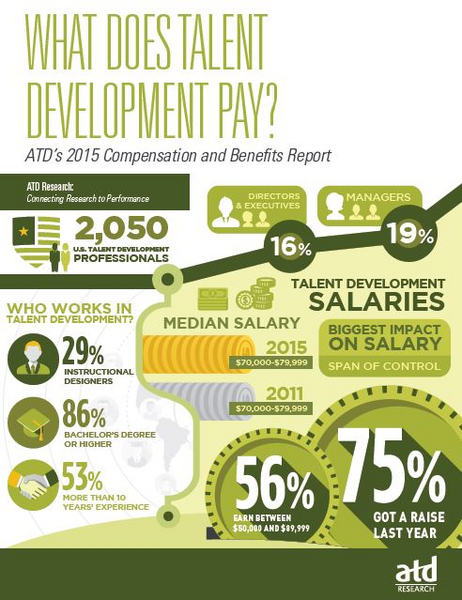ATD Blog
5 Facts Talent Development Professionals Can Use When Negotiating Their Salary
Tue Feb 16 2016

We all love making more money, but many people feel uncomfortable about approaching employers about raises or salary expectations. After all, it’s difficult without bringing some research to the table.
Luckily, ATD’s 2015 compensation and benefits report, What Does Talent Development Pay?, provides five key facts that will make talent development professionals feel confident when negotiating their salary and benefits packages. Drawing from survey responses from 2,050 individuals working at a variety of corporate levels across the United States, the report contains data on who works in talent development and their compensation.
1. It’s OK to ask for incentive compensation.
More than half of talent development professionals receive incentive pay, such as bonuses, stock options, or cash awards. For a nearly a third, incentive pay comprises between 1 and 9 percent of total compensation. For another 13 percent, incentives total between 10 and 14 percent of their earnings. Bonuses usually aren’t big slices of the pie, but are slices nonetheless.
2. Almost nine in 10 talent development professionals earn more than $50,000 per year.
Only 11.1 percent earn less than $50,000 in base salary, and less than 4 percent make under $40,000. Specializing in training delivery increases your likelihood of earning $50,000 or less and decreases your likelihood of earning $70,000 or more. This may stem from the fact that training includes many of talent development’s entry-level roles.
3. More talent development professionals make $120,000 or more in salary than make $50,000 or under.
More than 13 percent of talent development professionals earn $120,000 or more in yearly base salary. Holding a position of director or above, having 10-plus years’ experience, and living in the Northeastern or Western United States will each improve your chances of earning $120,000 or more. Most frequently, individuals earning at this level hold leadership roles. Also, regional differences in pay may reflect the higher cost of living in the Western and Northeastern United States, which contain the country’s 10 most expensive states to live in.
4. Three in four talent development professionals received a raise last year.
Of that 75 percent, roughly a third received raises of at least 4 percent. Most of the other two-thirds received raises worth between 2 and 4 percent of their total salary. For context, the cost of living in the United States has grown by less than 2 percent per year since 2012, according to estimates from the U.S. Social Security Administration.
5. Most talent development professionals have access to robust benefits packages.
First, they have consistent access to healthcare benefits. An overwhelming majority, 88 percent, were offered medical coverage by their employer. Other healthcare benefits abound as well: 94 percent of talent development professionals receive access to dental insurance, 90 percent receive access to vision insurance, and more than 80 percent receive access to short-term and long-term disability insurance. Talent development professionals also have ample opportunities to save. More than 90 percent were offered a 401(k) or similar retirement account by their employer, and more than 70 percent were offered a health savings account. Further, with a median of 20 paid days off, talent development professionals get plenty of work-life flexibility. About six in 10 receive 20 or more days each year. Another six in 10 report that their organization offers the ability to work from home.
For the full report from ATD Research, go here.
You've Reached ATD Member-only Content
Become an ATD member to continue
Already a member?Sign In
